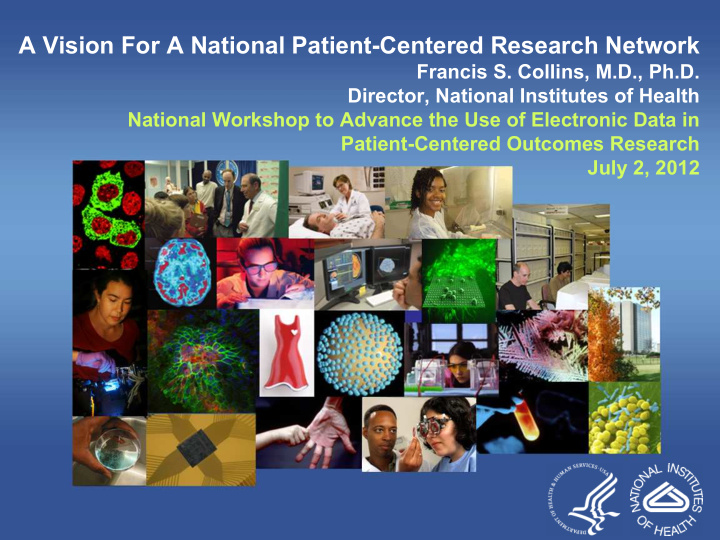



A Vision For A National Patient-Centered Research Network Francis S. Collins, M.D., Ph.D. Director, National Institutes of Health National Workshop to Advance the Use of Electronic Data in Patient-Centered Outcomes Research July 2, 2012
Why is it so hard to do effective and efficient clinical research? § Few pre-existing cohorts of substantial size § Even fewer with broad disease relevance § Absence of longitudinal follow up § Paper medical records the norm until very recently § Lack of population diversity § Vexing consent issues § Multiple IRBs § Privacy and confidentiality challenges § Chronic difficulty achieving enrollment goals § Limited data access § Heavy costs of start-up and shut-down
Imagine … A National Patient-Centered Research Network § Bringing together 20–30 million covered lives, with – Good representation of gender, geographic, ethnic, age, educational level, and socioeconomic diversity – Broad opt-in consents from 80 - 90% of participants – Longitudinal follow up over many years § Offering a stable research infrastructure – Including trained personnel in each of the participating health services organizations – Making it possible to run protocols with low marginal cost
Imagine … A National Patient-Centered Research Network § Drawing on electronic health records (EHR) for all patients, with – Interoperability across all sites – Meaningful use for research purposes § An efficient Biobank § Promoting data access policies that provide for broad research use but protect privacy and confidentiality § Providing governance with extensive patient participation in decision making
What Could We Do With a National Patient-Centered Research Network? § Rapidly design and implement observational trials – At very low cost § Quickly and affordably conduct randomized studies – Using individual or cluster design – In diverse populations and real-world practice settings § Significantly reduce usual expenses associated with start-up and shut-down of clinical research studies
Examples of Studies That Could Be Facilitated By A National Patient-Centered Research Network mHealth Applications § Prevention – Monitor obesity management programs – Assess sleep apnea at home – Support tobacco cessation § Chronic disease management – Continuous glucose monitoring for diabetes – Monitor ambulatory blood pressure in real time – Continuous EKG monitoring for arrhythmias § National patient-centered research network would ... – Provide a real world laboratory for assessing whether mHealth- based interventions actually improve outcomes
Examples of Studies That Could Be Facilitated By A National Patient-Centered Research Network Low Back Pain (LBP) § Most acute LBP resolves with conservative management § But about 20% of LBP becomes chronic – Common treatments: medications–physical therapy–chiropractic/ manipulative therapy–acupuncture–surgery – Complex fusions for spinal stenosis up 15x in recent decades § National patient-centered research network would ... provide large # of participants; longitudinal follow-up to – Determine how to prevent acute LBP from progressing to chronic – Compare risks and benefits of common treatments – Discern appropriate use of lumbar imaging for evaluation
Examples of Studies That Could Be Facilitated By A National Patient-Centered Research Network Large-Scale Pharmacogenomics § Example -- Clopidogrel (Plavix): powerful antiplatelet drug used in patients at risk for heart attack, stroke – CYP2C19 genotype may identify decreased responsiveness – FDA added black box warning – but other research has raised doubts about clinical importance of CYP2CI9 genotype § National patient-centered research network would … facilitate trials to examine conflicting data – Large-scale, rapid-fire clinical trial of patients with acute coronary syndrome, recent stroke, recent placement of drug-eluting stent • Randomized trial (individual or cluster) • Only short-term (e.g. 6 to 12-month) follow-up needed – Model could be applied to other pharmacogenomic questions By synchronizing with EHR data, one could do large definitive trials quickly at low cost
What Could Go Wrong? § EHRs won’t turn out to be that useful for research (hey, we’d better solve that one at this meeting!) § Business managers of health services organizations will perceive a conflict between health care delivery and research § Patients (especially underrepresented groups) will be unwilling to participate § The network will be too large to evolve when it needs to, and will become quickly ossified § An entitlement will be created – once a node in the network is supported, it can never be terminated
Why Now? § For the first time in the U.S., health services organizations with EHRs have reached the point of making this network feasible on a large scale § Scientific opportunities and the urgency of getting answers to clinical questions have never been greater § If we are ever to engage a larger proportion of the American public in medical research, we need to come to them – in partnership § General feasibility has been demonstrated through modest prior efforts (e.g. HMORN, eMERGE, etc.) § PCORI has arrived on the scene – and successful establishment of this Network, potentially with NIH and AHRQ as partners, could be PCORI’s most significant contribution and enduring legacy
2012: An Olympic Year
Patient-Centered Outcomes Research Works Best as a Team Sport So let’s go for the gold!
Recommend
More recommend